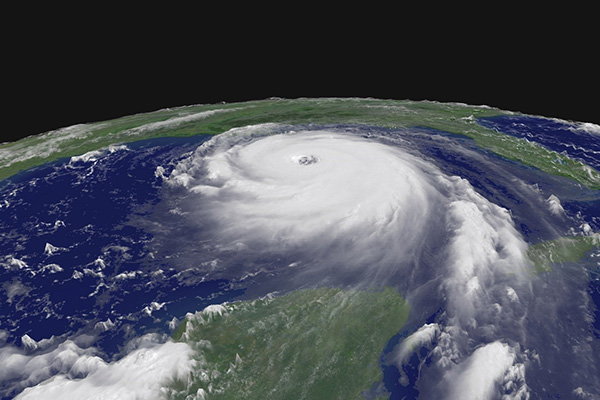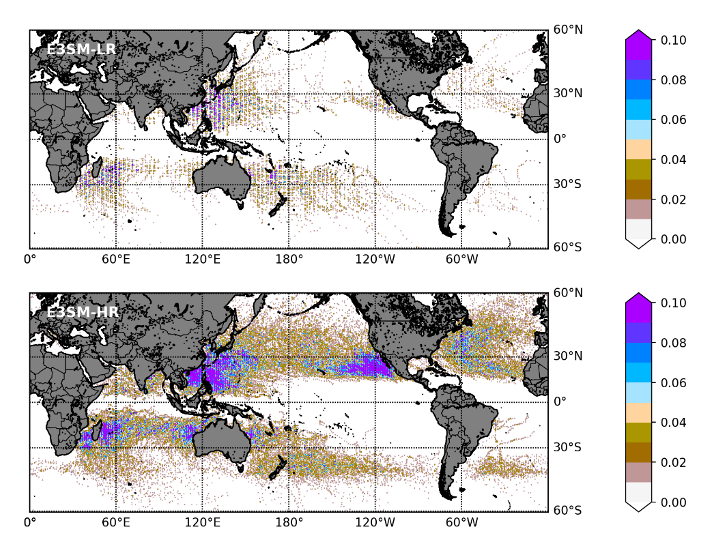Tropical Cyclone Simulation in E3SM

Example of a tropical cyclone from an E3SM model simulation of Hurricane Sandy. Higher resolution Earth system models allow for more accurate representations of tropical cyclones. Image courtesy of NASA.
New analysis assesses the realism and biases of tropical cyclones at various resolutions in E3SMv1.
The Science
Proper infrastructure planning requires accurately predicting how tropical cyclones respond to environmental changes. Making those predictions is challenging because Earth system models are generally run at low resolution and poorly simulate storm behavior. Analysis of tropical cyclones simulated by the Department of Energy’s Energy Exascale Earth System Model (E3SM) at low and high resolutions was performed to gain an understanding of how well they simulate storm characteristics such as frequency and intensity. The high-resolution configuration was found to be significantly better at simulating tropical cyclones and their interactions with the ocean below, underscoring the value of increasing model resolution. Further, at all resolutions, systematic coupled model biases introduced errors in simulating storm activity, notably in the subtropics, motivating the need for future improvements.
The Impact
This study demonstrates that the high-resolution version of E3SM is a valuable tool for tropical cyclone-related research as it well represents characteristics relevant to predicting hurricane impacts such as storm surge and flooding. The model is particularly useful for studies focusing on global tropical cyclone climatology and the role of air-sea coupling in these storms. In addition, the results suggest that reducing coupled model sea surface temperature biases could improve tropical cyclone simulation by reducing the spurious and unrealistic tropical cyclone activity produced in the model.
Summary

Figure 1. Tropical cyclones (TC) track density, defined as the number of track locations determined at 6-hour intervals in a specific area per year, from the low- (E3SM-LR) and high-resolution (E3SM-HR) simulations. The distribution of TC tracks improves significantly in the high-resolution version of the model globally.
Researchers analyzed version 1 of the E3SM model at both low/standard (1 degree – atmosphere) and high resolution (0.25 degree – atmosphere). Compared to the low-resolution simulation, the salient tropical cyclone features, such as the seasonal cycle, global frequency, lifetime maximum intensity, and distribution among different basins (Fig. 1), were improved noticeably in the high-resolution model. However, the model produced spurious activity in the subtropical southeast Pacific and the south Atlantic at both resolutions. An investigation of the large-scale tropical cyclone environment revealed that this spurious activity was likely the result of errors in the thermodynamic potential intensity caused by inaccuracies in sea surface temperature modeling. An examination of tropical cyclone-ocean interactions suggests that the model can resolve both the upper-ocean response to these storms and the ocean’s feedback to the storms realistically. Finally, the researchers found that the influence of the El Niño-Southern Oscillation on tropical cyclones in the model had the correct sign but was weak relative to observations.
Publication
- Balaguru, K, L Leung, L Van Roekel, J Golaz, P Ullrich, P Caldwell, S Hagos, B Harrop, and A Mametjanov. 2020. “Characterizing Tropical Cyclones in the Energy Exascale Earth System Model Version 1.” Journal of Advances in Modeling Earth Systems 12(8). https://doi.org/10.1029/2019ms002024.
Funding
- The U.S. Department of Energy Office of Science, Biological and Environmental Research supported this research as part of the Earth System Model Development program area through the Energy Exascale Earth System Model (E3SM) project and as part of the Regional & Global Model Analysis program area through the Water Cycle and Climate Extremes Modeling project.
Contact
- L. Ruby Leung, Pacific Northwest National Laboratory


